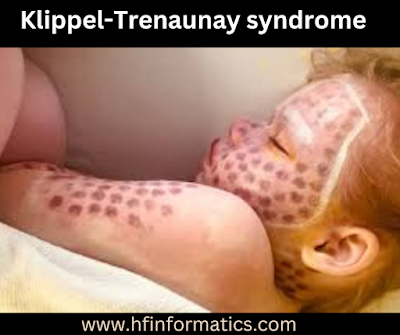Klippel-Trenaunay syndrome (KTS): Symptoms, Cuases, Diagnosis & Treatment
Overview:
Klippel-Trenaunay syndrome
(KTS) is a rare condition characterized by capillary malformations, limb
overgrowth or undergrowth, and varicosity. It is caused by genetic mutations 1, 2.
Management of KTS is
conservative, with compression therapy and laser treatment for port wine
stains. Diagnostic imaging is important before vascular interventions.
Treatment techniques, such as sclerotherapy, thermal ablation, or surgical
procedures, are personalized. Intraoperative measures like tourniquet use and
vena cava filters can help reduce bleeding and prevent complications. A
multidisciplinary approach is necessary for KTS management1.
Some patients may experience
life-threatening issues, particularly related to blood clots, so preventive
measures are crucial1.
What is Klippel-Trenaunay syndrome?
Klippel-Trenaunay syndrome, also known as KTS, is a rare
condition that occurs from birth and is described by 3 major symptoms include
- A red birthmark also called port-wine stain (ranging from pink to reddish-purple).
- Vein malformations (deformities)
- Abnormal overgrowth of bones and soft tissues. It happens usually in one leg but sometimes in the arms or (rarely) on the torso (trunk) 1.
Symptoms:
People with KTS may experience the following
characteristics, which can vary in severity:
1. Port-wine stain:
Port-wine stain is a pink to reddish-purple birthmark caused
by extra tiny blood vessels in the top layer of the skin. It often appears on
one leg but can affect any area of the skin. The birthmark may lighten or
darken over time.
2. Vein malformations:
These include swollen and twisted veins (varicose veins)
primarily on the surface of the legs. Deeper malformations can also occur in
the arms, legs, abdomen, and pelvis. Spongy tissue filled with small veins may
be present in or under the skin. These vein abnormalities may become more
noticeable as a person ages.
3. Overgrowth of bones and soft tissue:
This typically begins in infancy and may be limited to one
leg, but it can also affect an arm or, rarely, the trunk or face. The
overgrowth leads to a larger and longer extremity. In some cases, fusion of
fingers or toes or the presence of extra fingers or toes may occur.
4. Lymphatic system malformations:
The lymphatic system, which plays a role in immune function
and fluid transport, can be affected. Extra lymphatic vessels may be present
and not function properly, resulting in fluid leakage into the tissues and
swelling.
5. Other associated conditions:
KTS can also be accompanied by cataracts, glaucoma, hip dislocation at birth, purple-red skin coloration when exposed to cold, and blood-clotting problems.
Causes:
- KTS occurs due to somatic mutation in the PIK3CA gene2. A somatic mutation refers to an alteration in somatic tissues that occurs after fertilization. Alteration, in these genes causes overgrowth of tissues.
- The PIK3CA gene is responsible for the development of tissues and the growth of cells.
- KTS is typically not passed on from parents to their children. The changes in genes that cause KTS happen by chance during the division of cells in the early stages of development before birth.
Diagnosis and tTreatment:
Klippel-Trenaunay
syndrome (KTS) is managed in a conservatively, meaning that treatment
approaches are typically cautious and traditional. The extent of diagnostic
evaluation depends on the planned treatment. Compression therapy is a key
aspect of conservative management, while laser treatment can be used
specifically for port wine stains. Before any vascular interventions, imaging
is necessary to confirm the venous anatomy and deep venous drainage. The
techniques for treating superficial veins and malformations are personalized
and may involve sclerotherapy with alcohol or foam, endovenous thermal
ablation, or surgical stripping and phlebectomy. Intraoperative use of a
tourniquet can help reduce bleeding, and selective use of an inferior vena cava
filter can prevent certain complications1.
Complications:
Complications can arise from the abnormal development of
bones, soft tissues, blood vessels, and the lymphatic system in KTS. These
complications may include:
a. Vein malformations:
Varicose veins can cause skin ulcers and pain due to poor
blood circulation. Deeper malformations in veins can increase the risk of blood
clots (called deep vein thrombosis) and potentially cause a life-threatening
condition called pulmonary embolism if the clots travel to the lungs.
Malformations in the veins (located in the pelvis and abdominal organs) can
lead to bleeding inside the body. On the other hand, superficial veins may
develop less severe but still painful blood clots and inflammation1.
b. Port-wine stain complications:
Certain areas of the port-wine stain may thicken over time
and develop blisters that are prone to bleeding and infections. Skin ulcers and
difficulties with wound healing can also occur.
c. Overgrowth of bones and soft tissue:
Excessive growth of bone and tissue can result in pain, a
sensation of heaviness, enlargement of limbs, and difficulties with movement.
When one leg is longer than the other due to overgrowth, it can lead to walking
problems and potentially cause hip and back issues.
d. Lymphatic system malformations:
Malformations in the lymphatic system can lead to fluid
buildup and swelling in the arms or legs (lymphedema), skin breakdown, skin
ulcers, leakage of lymphatic fluid, or infection of the layer beneath the skin
(cellulitis).
e. Chronic pain:
Pain can be a common issue resulting from complications such
as infections, swelling, bone involvement, or vein problems.
Risk factors:
Having a family history of KTS does not appear to increase
the risk of having another child with the disorder. Therefore, even if one of
the parents has KTS, it is unlikely that they will have another child with the
condition3.
When to see a doctor?
It is typically during birth that KTS is recognized. It is
crucial to seek medical attention promptly to receive an accurate diagnosis and
appropriate care. This will help in managing symptoms effectively and
preventing potential complications






Post a Comment